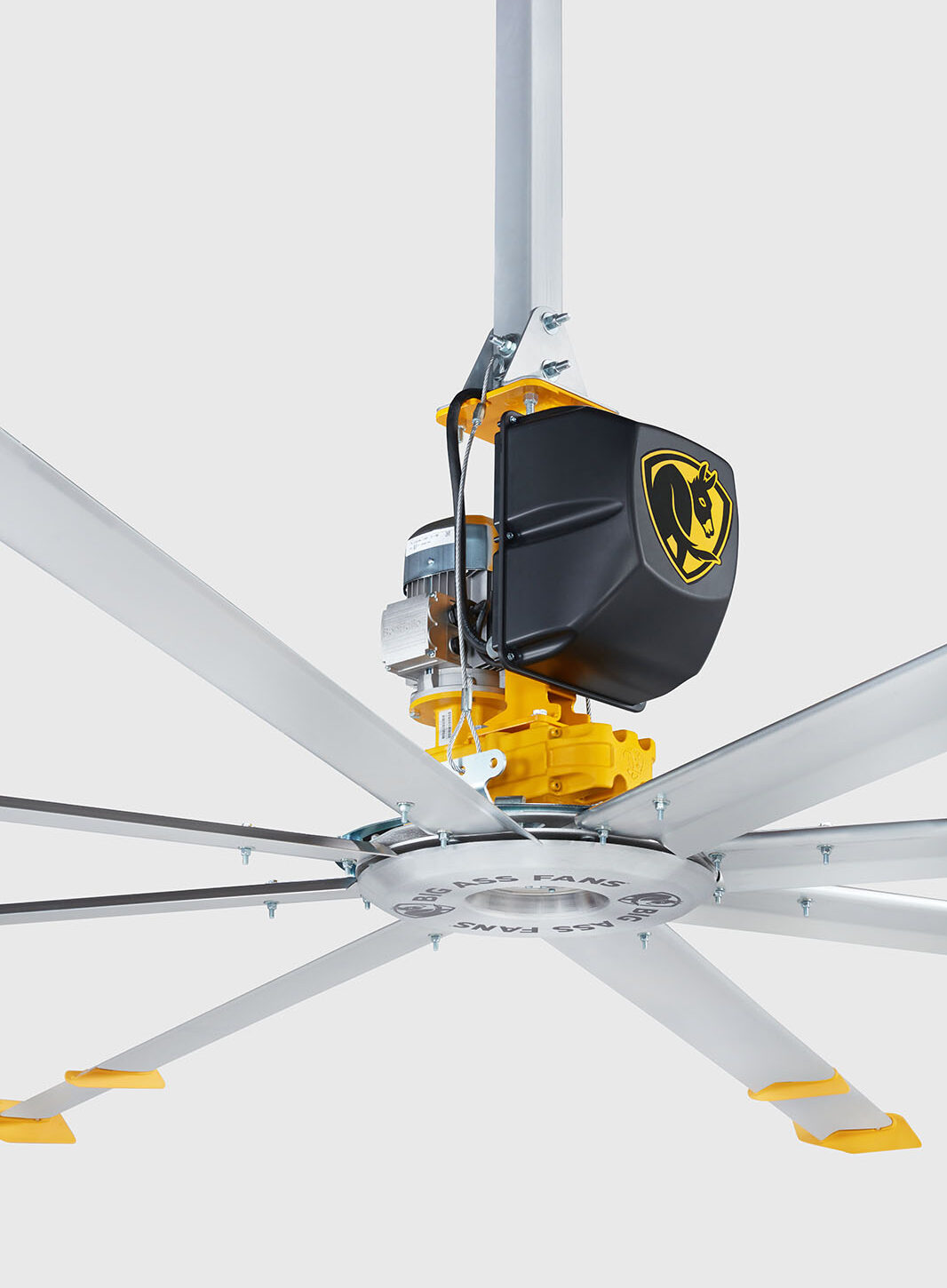Big Ass Fans Turns to Smart Software as Demand Heats Up
Big Ass Fans is the best-selling big fan manufacturer in the world, delivering comfort to spaces where comfort seems impossible. BAF had a problem: how to reliably plan production to meet demand. BAF was experiencing a gap between bookings forecasts vs. shipments, and this was impacting revenue and customer satisfaction. BAF turned to Smart Software for help.
BAF’s Supply Chain Manager took the lead to flesh out their planning needs and methodically address them. In his words, “it came down to fundamentals. Our planning process needed to be data driven, collaborative, and continually improved by assessing and enhancing our monthly forecasting process.”
A big part of this was bringing the disparate planning processes together. Product managers produce monthly demand forecasts, while the operations team forecasts shipments and associated material requirements. BAF needed a tighter, data-driven process that combines advanced analytics with team collaboration. This would need to address seasonality, a huge factor driving demand fluctuations, incorporate input from international as well as US markets, and capture the impact of market promotions.
BAF’s Customer Service Director and S&OP Team Lead explained what this means. “Now we have one unified, global process, one shared business view that provides the framework for all of our cross-business planning.” She likens it to having one source for the truth. “Every month the entire team sees updated orders and shipments and can compare forecast against actual performance. Individual managers view business through their required business lens – by product line or service, region, international geography, channel, customer, you name it.”
“This is enabling technology that makes us better,” she continued. “Smart IP&O is, among other things, the vehicle for our monthly SIOP process. We review our own business segments then convene as a group, consider results to date, the impact of promotions, events and seasonality, and agree on our consensus plan going forward. This is an invaluable process, enabling manufacturing to stay ahead of demand and deliver what our customers need, when they need it.”

“Smart Inventory Planning & Optimization is the critical tool we use to manage our forecasts across a large and dynamic set of Products/Parts, multi-national sites, and complex supply chains,” added the Supply Chain Manager. “The ability of the software to provide a statistical forecast as baseline, allow adjustments by various subject matter experts, each recorded as ‘snapshots’ for consensus building and later use in accuracy/improvement efforts, then ultimately feed the forecast data directly into our Material Requirements Planning software is central to our S&OP process.”
BAF has refined its monthly Sales, Inventory and Operations Planning process utilizing Smart Demand Planner, Smart’s collaborative forecasting and demand planning application. Smart’s API based bi-directional integration with BAF’s Epicor Kinetic ERP automatically captures all order and shipment data that in turn drives the creation of monthly statistical forecasts. Through its monthly SIOP process, BAF product managers produce initial forecasts, share these with sales managers who can suggest adjustments, and bring together consensus plans across 25 product lines for monthly review, adjustment, and presentation to the executive team as the company’s rolling 12-month plan.
The team credits Smart Demand Planner with providing a thorough and accurate forecast of future demand that is central to BAF’s monthly SIOP process. BAF extended Smart’s utilization to its international offices, where subject matter experts manage their own forecasts. “Within Smart they can manage both demand forecasts that key on their shipments to local end users and supply forecasts based on their purchase history as key customers to BAF-US. This significantly enhances our global demand view and has improved forecast accuracy.”
About Smart Software:
Founded in 1981, Smart Software, Inc. is a leader in providing businesses with enterprise-wide demand forecasting, planning, and inventory optimization solutions. Smart Software’s demand forecasting and inventory optimization solutions have helped thousands of users worldwide, including customers such as Disney, Arizona Public Service, and Ameren. Smart’s Inventory Planning & Optimization Platform, Smart IP&O, provides demand planners the tools to handle sales seasonality, promotions, new and aging products, multi-dimensional hierarchies, and intermittently demanded service parts and capital goods items. It also provides inventory managers with accurate estimates of the optimal inventory and safety stock required to meet future orders and achieve desired service levels. Smart Software is headquartered in Belmont, Massachusetts. Learn more at www.smartcorp.com.

About Big Ass Fans
At Big Ass Fans, we are driven by our mission to create safer, healthier, more productive environments worldwide. What started as a big idea in airflow became a revolution and is now best practice for designers, managers, and business owners across every imaginable industry and application. Today, our products are proudly spinning and serving more than 80 percent of the Fortune 500 in 175 countries. From factories to homes and everywhere in between, Big Ass Fans delivers comfort, style, and energy savings to make life more enjoyable. With more than 235 awards, 350 patents, an experiment on the International Space Station and the only HVLS Research & Design lab in the world, we go big every day.
Procon Pumps Uses Smart Demand Planner to Keep Business Flowing
Introduction:
Procon, an industry leading pump manufacturer, uses Smart IP&O’s demand planning and inventory optimization modules from Smart Software to make sure they have the products their customers need, when they need them. You might not have heard of their products, but if you’ve ever eaten at McDonalds or sipped a coffee at Starbucks, you have been served by Procon. Procon’s broad portfolio of over 7,000 SKUs is supplied to more than 70 countries worldwide through their direct sales channel and an extensive distributor network. Procon operates manufacturing facilities in the US, Mexico, Ireland, and through a licensed manufacturing partner in Japan. We spoke with Procon’s Shankar Suman, Director of Sales, and Emer Horan, Global Supply Chain Manager, to learn more.
The Challenge
If Procon cannot ship a required product, their customers cannot ship theirs. Accurate forecasting is a key driver of supply chain success and customer satisfaction. Procon’s monthly planning establishes the consensus demand plan that drives procurement, production, and stocking policies. But they found they had a gap between sales and procurement, which historically led to missed deliveries and excess inventory. What Procon needed was a robust demand forecasting and inventory optimization tool that was easy to use, enabled collaborative planning with their sales team and partners, and integrated with their ERP system to drive procurement and production planning.
The Solution:
They found this in Smart IP&O, web-based platform for statistical forecasting, demand planning, and inventory optimization.
- Shankar Suman cited a broad mix of capabilities that convinced them to utilize Smart. Chief among them were:
- Smart Demand Planner supports the easy, orchestrated flow of information that yields an accurate consensus plan. Presenting performance history and statistical forecast by product, territory, and partner, SDP provide the sales team with perspective that they can complement – adjusting for expected opportunities or demand shifts.
- Forecast accuracy. Smart is an industry leader in statistical analytics, leveraging innovations developed over its forty-plus year history. This combined with robust forecast vs. actuals analysis helps Procon continually improve the quality of their forecasts.
- Transparent connectivity with Procon’s enterprise software, Epicor Kinetic. Daily sales and shipment data are automatically pulled into the Smart platform, fueling Smart’s forecasting engine, and results are easily pushed back to the ERP (MRP) via an API based integration to drive ordering and production planning.
Results:
Emer Horan explained how this plays out over the course of each month. Emer provides forecasts for each of their five sales managers, they meet to compare statistical and sales forecasts, and agree on a revised 12-month consensus plan. The sales managers have a good sense for the top accounts that represent 80% of revenue, often including direct input from customers themselves, and the statistical forecast fills in the gaps. Next month they use the forecast vs. actual analytics to help improve accuracy, then repeat the process.
“Our sales team is incentivized to maintain and improve sales forecast accuracy,” said Emer, “and we have the tools to help them succeed. This not only ensures optimal inventory levels but also contributes to improved on-time delivery and higher customer satisfaction.”
“Our journey with Smart Software has been quite remarkable,” added Shankar. “We began with an initial idea of the functionality and interface, and it has continually evolved from there. The Smart team has shown tremendous support and patience with our scope changes, delivering the product exactly the way we needed and wanted it. We have been using Smart for over three years now, and this journey is ongoing. We continue to receive excellent support from the Smart team and truly enjoy working with them.”
ImpressArt Helps Entrepreneurs Create Beautiful Jewelry – aided by Smart IP&O
Planning with large retail partners improves availability, reduces costs
Introduction
Accurate forecasts are central to ImpressArt’s business model, the linchpin in its supply chain that ensures product availability through its strategic channel partners. Jeff Wolter, CEO of ImpressArt, explains why forecasting is so important, how he came to select Smart Inventory Planning and Optimization as Impress Art’s forecasting and demand planning system, and how better forecasts are helping their business.
The Challenge
ImpressArt found its market and grew exponentially in its first decade. “At ImpressArt we eat, sleep, and breathe jewelry making and hand stamping,” says Wolter. We help creative people of all skill levels make beautiful jewelry and become creative entrepreneurs.” These crafters and artisans purchase through three major retail chains and directly through ImpressArt’s fulfillment center. Availability is everything. If it’s there, they buy, if not they will go elsewhere.
As the company grew its supply chain became more complex, its product lines more diverse, with replenishment lead times from China-based factories stretching out 13 weeks or more. Then the Covid pandemic hit – it seemed that everyone was at home, eager to make things, and demand really spiked. Warehouse management took on a new level of urgency as the company experienced increasing inventory misalignment, stocking out in some areas, with excesses in others.
Requirements and Software Selection
The company needed a robust, adaptive forecasting and demand planning process to guide ordering and stocking of thousands of products. ImpressArt wanted a vendor that reflected best industry practices. Key requirements included:
- Setting optimal stocking policies and accurate forecasting. Stocking out means lost sales – buyers will go elsewhere – while overstocking consumes cash, crucial to surviving the pandemic.
- Collaborative planning with key channel partners. Michaels, Hobby Lobby, and Jo-Anne Stores drive a large share of ImpressArt’s business. Getting a window into their requirements is crucial.
- Dealing with long and variable replenishment lead times, routinely 13 weeks but fluctuating with Covid-related supply chain delays.
- Ability to methodically forecast and secure the supply of thousands of items, automatically discovering and addressing shifts in demand patterns.
- Integrations with ERP systems of choice: forecasting is so critical that ImpressArt needed to address this first with the knowledge that it will integrate with its chosen ERP down the road.

ImpressArt wanted a vendor that reflected best industry practices.
ImpressArt Selects Smart Inventory Planning & Optimization
ImpressArt narrowed its search down to 8 vendors and concluded that Smart alone excelled across all of the best practices. “I studied all the best practices from numerous sources and found that Smart’s approach was addressing everything,” said Wolter, “specifically better ways to develop the right policies and develop a forecast.” He points to a few areas in particular:
- Collaborative forecasting with key customers, large retail chains: Smart made it easy to plan all items for key named accounts and enter into a dialog with each. Getting this direct input, down to the point of sale, has proven to be enormously valuable.
- Highly visual, friendly user interface: “Data visualization matters,” said Wolter, “it impacts analysis, sets the tone.”
- More than ‘auto pilot’ planning: forecasts are easy to interpret, drill into, and adjust.
- Wolter appreciated the rich analytics – “I found the math to be a cut above. The numbers are right and enable us to generate orders accurately. Rarely do I see something that needs modifying.”
Wolter summed it up: “Smart is helping me save time and automate the inventory planning process, which ultimately is helping me scale our business. We now have a great inventory planning and forecasting process generating measurable value that can be plugged into whatever ERP we choose.”
Learn more about Smart Software at www.smartcorp.com.
Learn more about ImpressArt at www.impressart.com.

Electric Utility Goes Live in 90 Days with Smart IP&O and saves $9,000,000
The Challenge
The utility employs over six thousand people to operate a highly diverse mix of electric power generation and distribution facilities comprising ten generation plants, a large regional nuclear power plant, and thousands of miles of transmission, distribution, and underground cable. The utility offers an indispensable service, the continuous, reliable availability of electric power. Service is paramount. And key to this service is the availability of a myriad of service parts – over 250,000 of them – to keep its facilities running 24/7.
The utility launched a strategic Supply Chain Optimization (SCO) initiative to replace twenty-year-old legacy software. IBM Maximo was selected to provide core procurement, inventory and warehouse management, and work and asset management. Additional best-in-class capabilities would be added through the selection and integration of commercial off-the-shelf applications. Chief among these was the Inventory Optimization system, comprising Forecasting / Demand Planning as well as Inventory Optimization functionality. The utility pursued a comprehensive RFP (Request for Proposals) to drive its software selection.
Requirements and Smart Software Selection
Vendors were asked to respond to a broad array of functional requirements, in writing and then – by invitation – demonstrate in-person utilizing customer data. Forecasting and Demand Planning, Inventory Optimization, and Reporting and Analytics were all considered in depth. The requirements lists are long, but a few critical capabilities were especially important:
- Leverage proven, built-in statistical analytics that automatically model demand and produce accurate results across all demand types;
- Model and balance service level-driven inventory policies, across multiple locations and at multiple levels of aggregation, to produce optimal inventory stocking policies;
- Effectively plan for intermittent demand, most critical for spare parts planning;
- Effectively scale to automatically address planning requirements for over 250,000 discrete items;
- Easy to learn, use, and collaborate;
- Demonstrated ability to integrate with customers’ enterprise / supply chain management systems of choice.
Smart was selected for its performance across all of these categories. There were, of course, some standouts. First, during the live demonstration, Smart invited a member of the evaluation team to drive Smart Inventory Optimization. Within a few minutes they were able to log in over the Internet, assess inventory performance of select items, identify items that were overstocked, and target optimal service levels that showed significant opportunity for inventory reduction. This was a compelling exercise in usability.
Second, Smart’s unique treatment of intermittent demand, a patented, peer reviewed and field proven methodology, demonstrated effective and accurate service level planning, consistently achieving planned service levels on the most unpredictable parts.
And third, Smart’s demonstrated experience establishing automated integrations with our customers’ enterprise systems of choice established confidence that we would support the utility’s software solution architecture and integrate with Maximo.
Results to date
Implementation of Smart Inventory Planning & Optimization was accomplished within 90 days of project start. Over the ensuing six months, Smart IP&O enabled the adjustment of stocking parameters for several thousand items, resulting in inventory reductions of $9.0 million while sustaining target service levels. Significant additional savings – and improvement in service levels for critical spares – are anticipated in the coming year as stocks for additional facilities are brought into the system.
Learn more about Smart Software at www.smartcorp.com.

Field Service Parts Optimization at Seneca Companies
Introduction
Seneca Companies, an industry leader in automotive petroleum services, offers a broad range of service station design, construction, service, comprehensive containment and dispensing solutions. Seneca Fuel Systems serves the US Midwest, Southern and Mountain regions with a highly skilled staff of 75 field technicians charged with keeping client fuel stations up and running.
Seneca Fuel operates a central warehouse in Des Moines and 5 additional stocking locations to ensure rapid availability of critical parts. We spoke recently with Dan Miller, Purchasing Manager for Seneca Fuel, who explained Seneca’s inventory planning challenges and how Smart Software has helped.
The Challenge
Keeping fuel systems up and running is crucial to Seneca clients. Down-time means lost revenue and potentially lost customers. Seneca dispatches locally based service technicians equipped with essential parts with the goal of a 90% first visit fix rate. If they don’t have what they need on hand, they must be able to secure what’s necessary from a nearby warehouse in a matter of hours.
The stocking challenge is immediately apparent: which parts to carry in the van, in what quantity, and what to carry in the warehouses to supply them, ensuring maximum service performance while minimizing inventory investment.
When Seneca and Smart began working together, Seneca treated all techs the same with respect to inventory policy. A standard list of parts was supplied to each van, with an approximate of $35K per van. However, clients were not all the same and vary across geographic service areas. Service stations in Southern Illinois, for example, tended to be smaller and require different parts than counterparts in Denver. This increased the likelihood that some parts would stock out in some vans, while others might sit untouched for years. There was a section in the central warehouse dubbed “zero turns,” for items that just didn’t move, which grew to a value of $400K.
“Something needed to change,” said Miller. “We needed the ability to stock to the specific needs of the local tech, resupply them in a timely way from our warehouses, and equip the warehouses to play backstop for any other unusual requirements that van stock wouldn’t cover.” Compounding this challenge was the highly sporadic, intermittent nature of service part demand. “Traditional forecasting didn’t help,” explained Miller. “We see periods of zero demand with seemingly random, unpredictable spikes. We needed a methodology that would enable us to plan for this.”
The Solution
Seneca Companies turned to Smart Software and its cloud-based solution, Smart Inventory Planning and Optimization. Smart IP&O is an integrated suite of native web applications for collaborative demand planning, inventory optimization and supply chain analytics. Running on the Amazon AWS cloud, Smart IP&O serves automatically receives daily transactional data from their JD Edwards ERP system, models customer demand and inventory performance, and returns optimal inventory policies to JDE to drive replenishment.
“Smart IP&O integrated easily with Seneca’s enterprise systems, and enabled us to model stocking requirements for each technical rep and service area,” said Miller. “Implementation was quick and user training effective, producing initial results within 6-8 week of project start.”
A key capability has been Smart’s unique approach to planning for intermittent demand, the highly variable, seemingly random and unforecastable consumption most common with service parts. This has enabled inventory planning to move from educated guesswork to service level-driven modeling.
Results
“Smart IP&O enabled us to model demand at each stocking location and, using service level-driven planning, determine how much to stock to achieve the service level we require. By running and comparing different scenarios we can easily define and update optimal stocking policies for each tech support rep and stockrooms.”
The software has provided field technicians with evidence they did not have before, showing them their actual consumption, frequency of part use, and rationale for stocking policies, using 90% as the targeted service level norm. Field technicians have embraced its use, with significant results: “Zero Turns” inventory has dropped from $400K to under $100K, “First Fix Rate” exceeds 90%, and total inventory investment has decreased by more than 25%, from $11 million to $ 8 million.
Learn more about Seneca Companies at https://www.senecaco.com/.
Learn more about Smart Software at www.smartcorp.com.

Engineering to Order at Kratos Space – Making Parts Availability a Strategic Advantage
Introduction
The Kratos Space group within National Security technology innovator Kratos Defense & Security Solutions, Inc., produces COTS software and component products for space communications, tailored products for individual customers, as well as complete satellite and terrestrial ground segment solutions. Theirs is a highly demanding market often requiring engineered-to-order systems with exceptional performance and rapid delivery cycles. Kirk Smith, Vice President of Business Systems Innovation, sat down with us to explain how parts management and planning has become central to their operational excellence, supporting numerous custom projects per year.
The Challenge:
Engineering-to-order in Kratos’ world means that traditional finished goods forecasting won’t help you plan for the future. In the tailored marketplace, the past does not provide a usable forecast for the future, even within the Space group’s focused technology areas. You just don’t know ahead of time everything your next tailored system customer is going to request. This is problematic for the company’s contract manufacturers (CMs) that produce key lower level assemblies – they can’t know what to expect, and without some advice will have no ability to pre-order and stock requisite component parts. Short forecast horizons and long component lead times makes competitive bidding for new projects difficult, where time to delivery is crucial.
Leveraging a competitive advantage
“With tailored and custom solutions, the Number 1 reason we win is that we solve very challenging problems for our customers,” says Smith. But a close second is a strategic advantage – the ability to deliver those tailored systems quickly. Kratos has an array of previously designed and engineered building blocks (chassis and board level assemblies) that can be applied to newly designed solutions. This speeds design, but because these building blocks are tailored for each customer, stocking them for future sales is problematic – there are many variants. If Kratos could find a way to effectively forecast their board and component level requirements, they would be able to reduce end-to-end production time, minimize part shortages that delay delivery, and prevent excesses that create obsolete inventory.
The Solution:
Kratos pursued a hybrid planning approach, combining sales planning by its business development team with statistical forecasting from Smart Software. Smith explained the process:
Part 1 – Annual forecast at the CM built assembly level:
- Use Smart to produce a rolling 12-month assembly level forecast for the CM.
- Compare this with the Business Development Opportunity Forecast
- Merge the insights from Smart with the Opportunity Forecast
- Provide resulting adjusted assembly forecast to the CM for revenue and capacity planning.
Part 2 – Provide component level forecasts to Contract Manufacturers:
- Feed assembly level forecast into the ERP Bill of Material function, exploding component level demand for all parts.
- Aggregating demand by part number, generate component level forecasts.
- Provide forecasts to CM procurement to enable them to determine when to buy ahead or increase orders to capture volume price breaks. When they see an opportunity, they contact Kratos, get permission, and increase buys – with the effect of driving down material cost and lead times.
- Also, providing annual forecasts reduces buy-back pressure from the CMs – Kratos is obligated to buy back unused components, but now the CMs can see opportunity at the component level and the value of retaining stocks.
Results:
Over the past three years this approach has allowed Kratos to reduce material cost. Moreover, Kratos is able to work with its Contract Manufacturers to reduce stockout risk and achieve shorter delivery commitments. While dealing with components with up to six month lead times, they are able to confidently propose and achieve customer delivery dates.
Jon Good, General Manager at contract manufacturer NeoTech, shared their experience. “We use the Smart forecast provided by Kratos’ Space group to assist in taking advantage of price breaks on material at higher quantities that wouldn’t otherwise be visible in our current business model. This enables us to reduce material cost which translates into reduced pricing to Kratos in the long run.”
Good added that another use is to predict probable material consumption over a longer period of time than would be visible only on open orders. “This enables us to more realistically understand our inventory on hand position in terms of excess. These two benefits allow NEOTech to make smarter decisions related to purchasing and inventory management while at the same time saving days and weeks in the front end of the process and delivering the end product to Kratos as rapidly as possible.”
Looking forward, Smith sees even greater opportunity to team with Kratos Space CMs to streamline their supply chain and associated costs. “The bottom line,” says Smith, “is that we are now able to more effectively communicate with our CM partners, despite the lack of forecastability in our business, and simultaneously reduce material cost and shorten lead times.”








